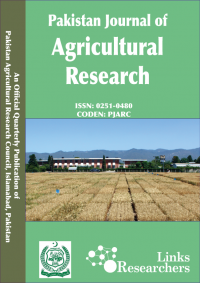PERFORMANCE OF SUMMER FORAGE LEGUMES AND THEIR RESIDUAL EFFECT ON SUBSEQUENT OAT CROP IN SUBTROPICAL SUBHUMID POTHWAR, PAKISTAN
Imtiaz Ahmad Qamar*, Maqsood Ahmad*, Gulshan Riaz* and Sartaj Khan*
ABSTRACT
The present study was conducted to assess the performance of five tropical forage legumes namely sesbania (Sesbania aculeata), cowpeas (Vigna unguiculata), rice beans (Vigna umbellata), lablab bean (Lablab purpureus) and cluster bean (Cymopsis tetragonoloba) with reference to a cereal fodder reference crop of millet (Pennisetum typhoides) and their residual effects on the succeeding oat crop at the National Agricultural Research Centre, Islamabad, Pakistan, under rainfed conditions without application of fertilizers in Randomized Complete Block Design. The highest dry matter yield was obtained from millet (8.9 -1 -1 -1 tha ), followed by cowpeas (4.5 tha ), sesbania (4.4 tha ), rice beans (2.9 -1 -1 tha ), lablab bean (2.2 tha ) while cluster bean produced lowest dry matter -1 (1.7 tha ). Cluster bean had the highest crude protein content (23.2 %) followed by cowpea (22.6 %), lablab bean (21.6 %), rice bean (20.1 %) and sesbania (19.1 %). Millet had the lowest crude protein content of 6.2%. Dry matter yield of oats owing to the previous crops was least after millet (7.5 -1 -1 tha ) and ranged from 8.5 to 8.9 tha after sesbania, cluster bean and cowpeas. Differences in crude protein content of oats as affected by the previous crops were non-significant and ranged from 9.4% to 9.7%. Differences in crude protein yield of oats as affected by the preceding crops -1 were statistically significant and ranged from 705 to 854 kg ha . These differences were due to variation in their dry matter. It was concluded that cereal legume sequenced cropping system gave overall higher yield of the cropping system. Inclusion of tropical forage legumes into the current cereal based farming system of Pothwar would not only increase forage availability to the underfed livestock of the area resulting in the increased livestock production but will also improve the N fertility of the soil. Potentially higher production of the subsequent non-leguminous crops will result as residual effect of this improved N status
To share on other social networks, click on any share button. What are these?






